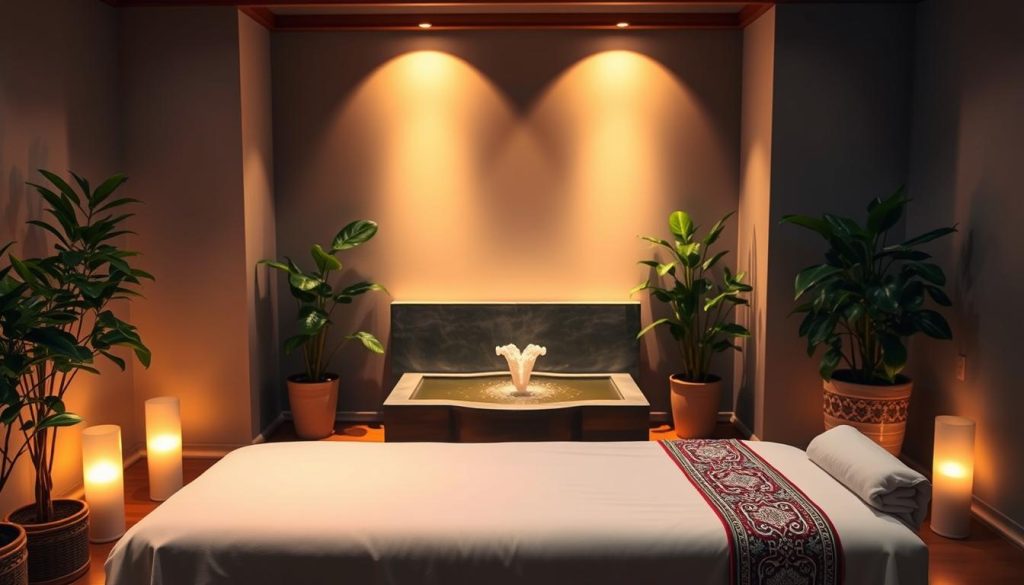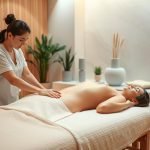Curious if a single session can truly loosen knots and restore your range of motion? Discover how a focused spa therapy can change tight posture patterns and reduce daily tension.
You arrive for a careful assessment so therapists learn your routine, posture habits, and sore spots. Then targeted stroking, kneading, and tapping work across upper and lower regions to ease stiffness and boost circulation.
Traditional Ottoman bath culture blends with modern methods here, creating a calm setting that supports comfort and clearer breathing. Aromatic blends—peppermint, lavender, chamomile, sandalwood—are mixed with carrier oils to soothe skin and relax muscles.
Expect hands-on pressure point care that addresses stubborn knots, often including neck and head work to help with sleep and stress. For details on this approach and booking options, see a full description at their back massage service.
Key Takeaways
- Personal assessment guides a tailored therapy plan.
- Techniques focus on circulation, fascia, and pressure points.
- Ottoman spa traditions combine with modern massage methods.
- Essential oil blends support relaxation and skin hydration.
- Therapists aim to reduce tension and improve everyday movement.
Expert Massage Therapy in Istanbul for Lasting Back, Neck, and Shoulder Relief
Skilled therapists use proven strokes and precise pressure to ease tight muscles around your upper spine and neck. Sessions combine stroking, kneading, and tapping to loosen stiff areas between the shoulder blades and along the upper back.
You receive focused work where posture and long hours cause the most tension. Therapists tailor each visit to your current pain level and mobility limits. This helps you move more freely after a single session and improves outcomes over time.
Pressure-point focus is offered to reduce stress and support better sleep. Some sessions also include head massage for full relaxation and improved circulation.
- Targeted care: upper back, between shoulder blades, neck.
- Custom pace: intensity adapts to your comfort.
- Lasting benefits: better circulation, less tension, improved sleep.
To book with expert therapists or explore options, see a local listing for full treatments on full body massage services or read about trusted individual practitioners at expert therapist profiles.
Relieve Back and Shoulder Pain with the Istanbul Massage Experience
A short consultation before treatment helps your therapist spot posture patterns and daily strain.
Targeted work concentrates on the upper back, the area between shoulder blades, and the neck. Therapists combine stroking, kneading, and tapping to soften tight muscles and improve blood flow.

How the massage technique works
Small circular strokes with palms or knuckles focus on stubborn knots so muscle fibers release without irritation. Gentle shaking follows to introduce a low vibration that helps tissues settle.
Personalized pressure and points
You guide pressure so each pass fits your comfort level. Therapists check specific points of strain and adjust technique to reduce tension gradually.
- Massage targets: upper back, shoulder-blade space, neck.
- Techniques: stroking, kneading, tapping, small circular motions.
- Aftercare tip: simple stretches and posture cues to keep muscles calmer between visits.
For local treatment options and comfort-focused selections, see a practical guide on relaxing session choices.
Proven Benefits: From Muscle Tension Relief to Better Mobility and Relaxation
A focused session targets tight areas to ease chronic stiffness and restore range of motion. You feel the difference when coordinated strokes, kneading, and tapping work together to loosen knotted tissue.
Chronic stiffness and lasting pain reduction
Consistent technique reduces muscle tension across your upper areas so everyday tasks hurt less. Over a few sessions, chronic stiffness often decreases and comfort improves.
Improved circulation to speed recovery
Better blood flow brings oxygen and nutrients to tight spots. This circulation boost supports healing and lowers soreness after activity.
Greater mobility and flexibility
As knots soften, soft tissue becomes more pliable. You regain mobility and notice increased flexibility during workouts and daily movement.
Stress relief, better sleep, and calm
Pressure-point work eases stress and promotes deeper sleep. The result is clearer rest and a calmer mind that helps sustain physical gains.
- Noticeable relief from chronic stiffness and ongoing muscle tension.
- Enhanced blood circulation to support recovery.
- Improved mobility and flexibility for smoother movement.
- Stress reduction and better relaxation for overall well-being.
For tips on keeping results between visits, see this healthy living guide.
Massage Modalities We Use to Target Your Needs
Your symptoms guide the choice of therapy, from firm, slow strokes to gentle point work on hands and feet.
Deep Tissue Massage Istanbul uses slow, deliberate strokes and firm pressure to reach deeper muscle and connective tissue. This deep tissue approach helps break down long-standing knots, improves flexibility, and boosts circulation for chronic muscle pain and recovery.

Reflexology for Hands, Feet, Ears, and Face
Reflexology focuses on specific points on your hands, feet, ears, and face to calm the nervous system. This lighter method reduces stress and improves circulation without intense tissue work. It’s ideal when you want relaxation and better sleep.
Turkish Back and Neck Focus
The Ottoman-inspired back and neck protocol blends targeted points with aromatic carrier oils. Therapists apply precise pressure points to soothe tight areas in your back and neck, helping muscles release while preserving a relaxing spa rhythm.
“We recommend choosing deep tissue when knots are chronic; pick reflexology for overall calm.”
- Choose deep tissue massage for stubborn knots and lasting change.
- Pick reflexology to ease stress and improve circulation gently.
- Combine therapies when you want targeted care plus full relaxation.
For practical tips from local therapists on matching therapy to goals, see recommendations from experienced therapists.
Your Session: Duration, Techniques, and What to Expect
Begin your session with a quick goal-setting chat so your therapist knows what your body needs and which areas to prioritize.
Session length options
You choose clear duration options in minutes to match priorities: short targeted work or a longer full-body visit. Typical choices are 30, 60, or 90 minutes so scheduling is simple and predictable.
Preparation, oils, and simple aftercare
Preparation is minimal: arrive hydrated and wear comfortable clothing. You set pressure and can give feedback during the massage so the pace stays right for you.
Essential oils such as lavender for calm, peppermint for clarity, and chamomile for unwinding are available. These are blended into carrier oils like coconut or grapeseed for a light glide, or olive and sweet almond when extra moisture is preferred.
Technique sequences start with a warm-up, then stroking, kneading, tapping, small circular motions, and gentle shaking. This order boosts blood flow and helps massage helps you relax into deeper work.
“Tell your therapist what you want to feel at the end—this keeps every minute focused on your goals.”
- You set goals at the start so the plan fits your needs.
- Essential oils are chosen safely and tailored to skin comfort.
- Aftercare includes hydration, light movement, and simple stretches.
| Duration (minutes) | Focus | Common oils used |
|---|---|---|
| 30 | Targeted neck and shoulder area, quick relief | Peppermint in grapeseed |
| 60 | Upper body balance, combined techniques | Lavender in coconut |
| 90 | Full-body session with extended hands-on time | Chamomile or sweet almond blend |
For VIP options and tailored packages, consider booking a session through this local guide to top services: VIP massage services.
Book Your Istanbul Massage Today for Effective Pain Relief
Book a session that starts with a short goals chat so your therapist can map a focused plan.
Teams trained in deep tissue apply slow, deliberate strokes and firm pressure to reach deeper layers. This approach reduces chronic discomfort in your back, neck, and nearby areas while supporting better circulation and tissue flow.
Pressure-point work, rooted in Ottoman-inspired techniques, targets tight spots to support relaxation and better sleep. Soothing essential oils enhance comfort and make the session feel restorative.
Therapists trained in deep tissue, pressure points, and Ottoman-inspired techniques
- You can book now at a respected spa and work with experienced therapists.
- Choose the right mix of therapies to meet your needs—from focused back work to a full session.
- Your therapist adapts methods to maximize relief while keeping you comfortable.
Secure your spot now to restore comfort, improve circulation, and relax your body
You support healthy circulation and soft-tissue flow with techniques proven to calm overworked areas. Expect clearer notes on expected results and how many sessions help maintain mobility and flexibility.
You can schedule at convenient times and pick a room setting that promotes calm relaxation. Enjoy a calm check-in, a focused session, and simple aftercare steps so you leave feeling ready for your day.
“Secure your spot today to prioritize your health and return to daily life with less pain and more confidence in your movement.”
| Booking option | Focus | Expected benefit |
|---|---|---|
| 30 minutes | Targeted back and neck | Quick pain relief, improved mobility |
| 60 minutes | Upper body balance, mixed techniques | Better circulation, reduced tension |
| 90 minutes | Full session with deep tissue & pressure points | Lasting flexibility and calm |
Ready to book? Find trusted options and select therapists through this local guide: top therapist listings.
Conclusion
Choose a focused plan that matches your goals so each session works on what limits your movement.
You get expert sequencing of strokes, pressure, and targeted points to ease muscle stiffness and reduce tissue tension. Deep tissue sessions use slow, firm work to break knots, while reflexology and blended therapies calm stress through hand and foot points.
These approaches support blood circulation and help tissues regain flexible flow. Combining essential oils in carrier oils soothes skin and helps muscles settle after focused tissue massage.
For clinical notes on short-term shoulder benefit after massage, see this study at clinical evidence. For practical local guidance on deep tissue and reflexology techniques, visit a trusted resource: professional therapist guide.






